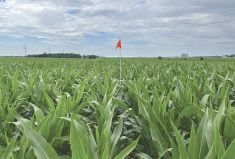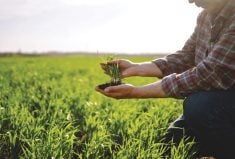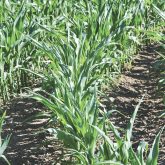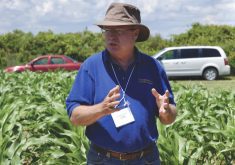Last fall, Dr. Sarah Rotz, then working at the University of Guelph, wrote an article with Guelph crop scientist Dr. Ralph Martin and York University agri-food policy researcher Dr. Rod MacRae to draw attention to what they perceive as shortcomings in the Ontario government’s Soil Health Strategy.
It’s a topic Rotz had been studying for the past few years. She surveyed more than 100 conventional grain farmers from southern Ontario, conducting in-depth interviews with 25 of them and taking soil samples at their farms. She also conducted focus groups with farm groups, industry, academics and OMAFRA.
Rotz has travelled across Canada and into the U.S. asking “What’s standing in the way of healthier soil?”
What she heard is: It’s not a lack of technology. It’s a lack of political will and financial support.
The results of these conversations will be compiled in a book, tentatively called Uncertain Harvest, which Rotz expects to be available next year.

Rotz, who has a PhD in the social sciences, came to the subject of agricultural soil health from a unique perspective. She says she wanted to make the connections between environmental politics, climate change, and soil agroecology, with how we are growing food.
She asked a lot of questions. Why are we growing food the way we are? What methods are we using and why? How is that impacting the soil? How is that impacting our ability to mitigate and adapt to climate change and what’s that going to look like 20 years down the road? What are our governments funding? What aren’t they funding and why? “Previously people focused on one or the other,” she said.
Read Also

Producers aren’t panicking over tariffs and trade threats
The influence of tariff and trade uncertainity on farm business decisions.
Country Guide caught up with Rotz, now working as a researcher with Queen’s University in Kingston, to delve deeper into the topic and find out what kind of response the trio got to their call to action.
Q. You released a paper in the fall of 2018 with the title “How Ontario’s soil health strategy falls short” along with Martin and MacRae. What was the impetus for releasing your call to action at that time?
A. Ontario had recently released “New Horizons,” their agricultural soil health strategy. We were responding to that report but at the same time this also came out of a larger project that MacRae, Martin and I were co-leading. That was a process between various stakeholders — farmers, OMAFRA, academics — coming together for a longer-term circle process. (A circle process brings together all those affected by a situation.) What came out of that was this real need to have a conversation about soil health.
Q. What kind of feedback did you get from the article?
A. It was largely positive especially from those not involved in agriculture. People told me “I never thought about soil organic matter or soil health being important before.” In our circle process we talked a lot about how to engage consumers. It’s hard to make the connection between the pepper they are picking up in the grocery store and the importance of soil health… It’s not clearly there.
Q. How do you define soil health?
A. We could define soil health as having high levels of organic matter, having a balanced level of nutrients, not being susceptible to erosion… those are all elements of healthy soil. I think it’s about the capacity of that soil in a flood or drought situation to retain its structure and to be able to cycle nutrients and to support biological communities. Organic matter is one of our best measures.
In the bigger picture, soil health allows us to reduce contamination of water, reduces pollution, contributes to the more natural habitat nearby, and reduces runoff of fertilizers and pesticides. We’re seeing that in our water systems time and time again.
Q. There’s been a lot of talk about soil health by governments, and many farmers are planting cover crops, reducing tillage, etc., but you don’t think this goes far enough. Why?
A. (There’s) a lot more that can be done given the centrality of soil health to the larger health of our food systems, our natural systems and our built-up urban systems. It’s all connected. We’ve recently received very stark information from the IPCC about the future of climate change, that we have only 12 years to turn things around. (go to www.ipcc.ch and search for Special Report on Global Warming.)
I think a lot more can be done in terms of supporting the enhancement of Soil Organic Matter (SOM). Economically, farmers are stressed; there’s not a lot of support to farmers for soil health.
I heard from farmers that “I understand the value of soil health and improving SOM but I’m cash-strapped right now and the system I am working within is forcing me to focus on my next crop, not focus on the longer-term vision of improving my soil, or improving natural habitat, or diversifying my crops. I’m not receiving any support for any of those activities.”
I really think the government can be going much further to support those kinds of activities. We know that these things work. Allow farmers to look at the bigger picture of their farm and to look at the longer-term vision.
Q. What role do you think the government should play in improving soil health, and what level of government should be involved?
A. We don’t have a comprehensive landscape scale of soil assessment. The farm operates within a larger ecological and social context. I think there’s a lot more to be done around supporting farmers to do those assessments more regularly.
It’s also the province’s jurisdiction to support education. I think that’s a big piece of it too. Within the primary and secondary school curriculum, are youth learning about the role of soil health, getting their hands into the soil, learning about mitigating environmental degradation, how soil health can mitigate climate change, soil management systems and especially around reconciliation, learning about Indigenous food systems and farming systems?
Q. What is being done by the various levels of government so far in Canada? Does it go far enough? If not, why?
A. One thing that is problematic is our focus on exports. I understand that we can’t be completely food secure or sovereign within the Canadian context but I’m very concerned our focus on exports is happening at the expense of supporting (and) encouraging local production and local distribution. I hear a lot of farmers saying the only things (that are) profitable are corn and beans.The science has said more complex rotations improve soil health. How can we support local or regional markets? We know people are interested in eating pulses and beans but we’re not putting our money into supporting those markets. If we keep focusing on how to export those pulses or how to export corn and soy we really miss out on the synergies of more complex (crop) rotations. And we know that pulses can be fairly cheap, which is an important piece around food security and food access.
Q. In your opinion, how can or should we measure progress in improving soil health?
A. (We) need some sort of mandated measure every five years. It needs to be supported — create a system for farmers to submit. We need trained folks who can meet with farmers and peer-to-peer learning groups to help farmers. We need a shift — not measuring in a punitive way but how do we all support each other in building up SOM? There are a number of ways to incentivize farmers.
The whole hands-off approach to the way land is understood and the private system of land going to the highest bidder… I don’t think that’s a good way of being on the land. Generally, I think we need to have a bigger conversation about land ownership and land management.
However, barring a more significant conversation by us on the part of government, especially around reconciliation, and a nation-to-nation relationship, how can we rethink our relationship to land in the short term?
The province could be mandating or incentivizing contracts between owners and renters that include those kinds of practices.
It may make it harder for farmers to keep growing and expanding their land base, but I don’t think that’s a bad thing if we calm things down a bit in terms of the land expansion models. Farmers are participating in it, but that doesn’t mean they like it. That’s an important distinction.
Q. You are a proponent of shifting away from export markets to more localized fruit and vegetable markets. Seems like it would be a big change. How quickly do you think that could happen? What supports would farmers need?
A. I think it can be done. Look at how we shifted agricultural markets the other way. The post-war era showed the capacity to change things. I don’t think there’s any question we can do it.
I think the problem often lies in thinking “we’re already going this way so how can we change it” without the realization that we’ve made pretty big changes in the past.
Young farmers are interested in localized grain or vegetable production or they are interested in low input, nut trees, integrated livestock and pasture. (But) the vast majority of our government funding is going towards export crops.
I think that maybe people are scared of shifting away but I also hear a lot of desire for that shift away. I think if we would put more money towards that, there would be less fear if people had the support.
This would line up with healthy diets, and food security. We know that food security is a big issue in Canada — 12 to 13 per cent (are food insecure). We know it’s a political issue, an issue of income, an issue of marginalized communities, racialized communities.
Localizing food systems will help towards those communities as well.
















